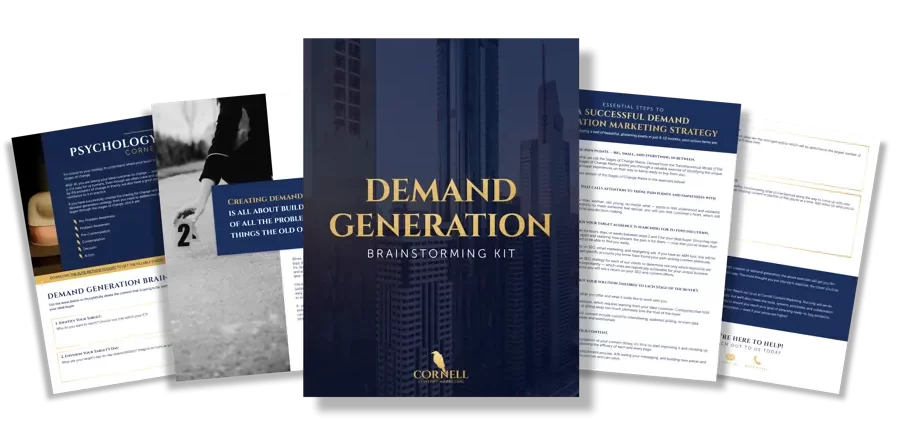Have you ever been in a situation where someone just assumes that you need what they have to sell — without ever really getting to know you, your business, or any of the things that really matter?
It’s all too familiar. A sales representative eagerly dives into a rehearsed speech about his or her company’s product, claiming that they can “help” you with that product… But how on earth can they help if they don’t even know what, if anything, you are struggling with?
Companies often fail to form authentic connections with their audience when they assume that a potential customer needs their services or product without taking the time to understand their potential customer’s pain points.
Read on to learn THE common sense, go-to marketing strategy that will connect you with your ideal customer in a simple, straight-forward, no-BS way that builds a long-term relationship and brand loyalty.
Common Sense Marketing
Successfully developing long-term customer relationships hinges on understanding client needs – and doing so in a way that facilitates conversation, shows genuine compassion, and puts the customer – not the sale – first.
A few years ago, I was working with an IT consulting firm that put a heavy priority on understanding client needs. While they had five- and six-figure service packages that they were eager to sell, they knew the importance of building rapport and human connection before offering up their solutions.
This company took the time to get to know their clients, meet the key individuals who they’d be working with at the company, and understand what each person’s daily working routine was like and what they struggled with – all before making the pitch!
Because they took the time to understand their clients, they closed nearly 100% of the deals they pitched.
Now, as a product-based business, you don’t have to go to that extent to sell a $45 subscription box. However, rather than going customer-by-customer to learn their needs, you can learn the needs of the community you’re serving.
In fact, failing to do so will lead you to craft the wrong messaging, choose the wrong products, and invest in the wrong marketing strategies.
On the other hand, when you do take the time to do what I call “Audience Investigation” and really get to know the people your product is for, potential buyers will see themselves in your messaging, be grateful for your marketing, and fall madly in love with your product, thereby becoming long-term customers with a high LTV.
All of this together is exactly what I love about the work I do — and it’s the go-to marketing strategy that I deploy with all of our subscription clients: build long-term relationships.
Build Relationships
When you listen to your customers and you treat them like real people — the same way you would want to be treated! — your company can connect better, nurture better, sell better, and retain better. Jumping to any one of these goals without building those relationships first is a surefire way to waste a lot of time and money.
As we know, in the subscription industry, it’s far cheaper to retain a customer than to acquire a new one. So take the time to listen to your customers and truly understand their world, their life, and their experiences.
It’s human nature to want to stay where we feel understood, seen, and valued. When you build a relationship with your customers, you foster that rapport and deliver on those most basic, yet often overlooked, human needs.
In a B2C world, it’s not always possible to call up your customers and have a frank conversation – or some variation thereof. That’s why we’ve defined a set of methods that allow you to become part of the conversation.
At Cornell Content Marketing, we call this Audience Investigation. Here are a few simple ways to use Audience Investigation as part of your go-to marketing strategy.
Search Amazon Reviews
A great way to find out what your audience is looking for in a product similar to yours is to look where they’re buying and voicing their concerns. Look up products that are similar to your own on Amazon, search the reviews, and see what questions people are asking.
What is your audience saying about the product? What are they complaining about? Why did they give it the star rating they did? You’ll soon see patterns that help you identify your audience’s natural language, desires, and pain points.
Free Demand Gen Resource:
Win Hearts Today,
Close Deals Tomorrow
Demand generation is the most effective way to establish trust and authority with savvy B2B shoppers while attracting buyers who recognize your brand as the best on the market.
Cornell Content Marketing’s Demand Gen Brainstorming Kit sets you on the right path for building an effective and efficient bridge between you and your target buyers.
Join Community Forums
Search for conversation relevant to your product by scouring online spaces such as Facebook Groups, Reddit forums, blogs, and review websites (like MySubscriptionAddiction).
Use these platforms to conduct thorough Audience Investigation. Join the conversations and ask questions. Even if you remain a bystander, you can gain significant information at no cost — and with minimal effort.
Discover the Facebook Ad Library
The Facebook Ad Library is a searchable digital library of current ads running on Facebook. Search for ads run by brands similar to your product or service to see how other businesses are advertising.
More importantly, look at the comments Facebook users are leaving on these ads. Click into the live ad and read the responses.
Are people enthusiastic? If so, about what? Are they irritated? If so, with what?
Read Comments on YouTube Videos
Another way to learn about what your audience wants is by reading YouTube video comments. Search for videos that align with your product and audience, including unboxing videos, product reviews, or how-to tutorials.
For example, if you run a subscription box that delivers CBD products to consumers, search for product reviews of other CBD products. Read the comments people are posting on the videos to see what questions they are asking, what they love, and what they’re dissatisfied with.
Let Market Trends Inform Your Marketing Strategy
Review market trends from sources like Pew Research, Forrester, or Gartner. These sources conduct polling and demographic research that you can use to gain quantitative insights into your audience’s behaviors and motivations.
Depending on your industry, you can also find reports from relevant sites that conduct research, such as Hubspot.
Your Go-To Marketing Strategy to Build Relationships
If I can leave you with anything today, it would be this: talk to your customers. If you can’t talk to them, listen to them. Engage with them. Join their conversations. Find more opportunities to interact with them.
Think about it from your own perspective — it bothers you when people try to sell you something without understanding your needs, right? So make sure you’re not accidentally doing the same thing to your audience.
Adopt long-term relationships as your go-to marketing strategy — because the only way a brand survives (let alone thrives!) long-term is with a positive relationship with their customers. All worthwhile things take time. So start out on the right foot: with your customer experience and relationship as the first priority.
Not sure where to start? We’re happy to help. Comment below or email Cornell and we will help you create a custom marketing strategy informed by thorough Audience Investigation into your right-fit customers!








